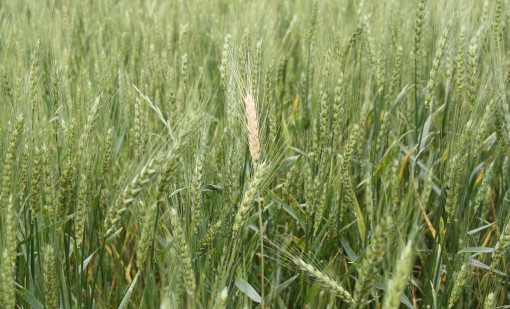
Agricultural News
Drought and Stress Blamed for White Heads in Wheat
Wed, 09 May 2012 10:16:46 CDT

As harvest draws closer, more and more white heads are appearing in wheat fields. Dr. Jeff Edwards and Dr. Bob Hunger looked at several fields and plant samples over the past couple of weeks and have found a few plants affected by take all and dryland root rot; however, the vast majority of white heads appearing in wheat fields are attributable to environmental (abiotic) causes. White heads caused by abiotic injury can be lumped into two categories: freeze injury and heat/drought stress.
Freeze
Given the very warm winter, one would not expect to see freeze injury this year, but some freeze injury has occurred. The picture to the right was taken in mid April in Stillwater and is definitely freeze injury. Many, including me, initially thought freeze injury was the cause of most of the white heads appearing in wheat this spring because the symptoms look very similar to freeze injury. Upon closer inspection and review of the literature, though, it has become apparent that most white heads are due to drought/heat stress.
Drought and/or heat stress
In Oklahoma it is nearly impossible to separate drought and heat. Much like an evaporative cooling fan in a greenhouse or shop, plants use water to cool themselves. Water is taken from the soil by roots, moved upward through the xylem, and transpired through the stomata in the leaves. When daytime temperatures soar north of 85F (optimal temperature for wheat is 77F) the plant has trouble transpiring enough water to keep itself cool, even if there is an ample water supply in the soil. Limited soil moisture and a larger number of tillers pulling water from the soil will compound the temperature effect and make the plant overheat even more quickly. Depending on when and where this overheating occurs, it can result in loss of whole tillers or green tillers with white heads.
Whole tillers turned white
Much like animals, plants produce hormones that regulate activities. Plants under stress produce a hormone called abscisic acid (ABA). ABA can be produced abundantly in the roots or leaves of stressed wheat plants and then distributed throughout the plant as a signal that things are not going well. The plant responds by decreasing growth rates and even cutting off carbohydrate and nitrogen supplies to plant parts, resulting in aborted or sloughed tillers that turn white. Think of it like sealing a hatch to a damaged portion of a ship to prevent the whole vessel from sinking.
Green stems but white heads
The wheat plant is most susceptible to stress at or just before anthesis (flowering). The male floral parts or stamens (filaments plus anthers) are very sensitive to stress as are the pollen grains themselves. Drought or heat stress at the time of flowering can result in sterilization of grain sites prior to fertilization. This is essentially the same effect as a freeze event at flowering, and the ultimate result of both stresses is the same: green stems with white heads.
Why this year?
So, why is this so prominent in 2012 and not in previous years with drought and heat? Evidence is clearly circumstantial, but there are a few suspects that should be brought in for further questioning. First, we have two to three times the normal number of tillers and wheat plants were operating at the margin of their ability to sustain these tillers. Operating on such a thin margin meant that any stress would cause the plant to "cut back". Second, we are coming off of one of the most devastating droughts the region has ever seen. We had a few timely rainfall events to keep us going, but subsoil moisture was absent in many parts of Oklahoma leading up to and during flowering. Finally, the warm winter likely had an effect. I couldn't find anything in the literature to support this hypothesis, but the mildness of our winter and the earliness of the wheat is one of the biggest differences between 2012 and other years with drought/heat stress.
More data for inquiring minds
A group of Australian researchers investigated the interaction of drought and heat with the hypothesis that a short period of high temperature might accentuate the effects of drought on wheat. Wheat plants were grown with adequate water under 73F daytime and 59F nighttime temperatures. To create a drought treatment, water was withheld from seven days prior to flowering to 13 days after flowering. To create a heat treatment, plants were subjected to 82F daytime and 68F nighttime temperatures at three days after flowering for a period of ten days. So, there was a group of plants that received just the drought treatment, a group that received just the heat treatment, and one group that received both.
A few take-home messages:
--The effect of drought was greater than the effect of heat and the primary effect was on grain weight (size).
--The effect of heat combined with drought was far greater than either treatment by itself.
--Heat plus drought reduced average grain weight and grain yield per head by nearly 50%.
--The temperatures used for the heat treatment (82F daytime) were 10 - 20F cooler than daytime temps in SW and western OK during flowering this year.
WebReadyTM Powered by WireReady® NSI
Top Agricultural News
More Headlines...



















